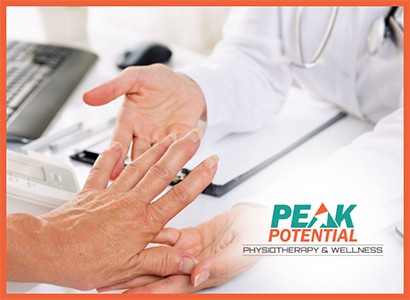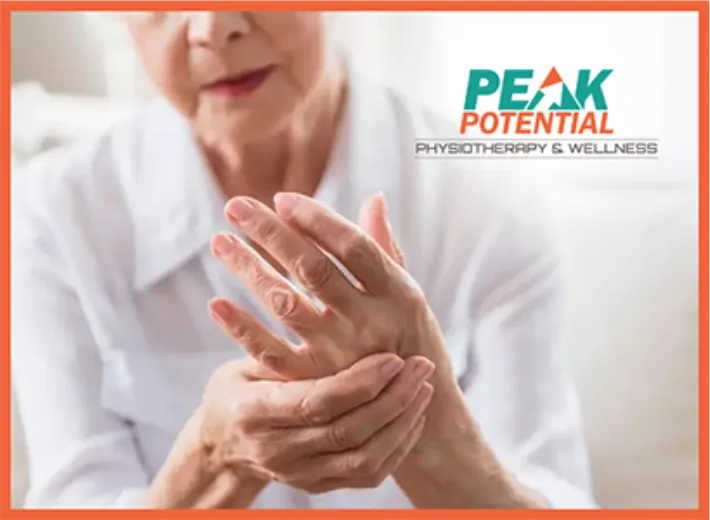Arthritis is the swelling and tenderness of one or more joints. The main symptoms of arthritis are joint pain and stiffness, which typically worsen with age. There are many ways you can ease the pain, and physical therapy is the most effective. Along with our expert care and assistance, you can also improve on some aspects of your daily routine to help you with the pain and discomfort. Learn more below.
In the United States, arthritis affects more than 50 million adults and 300,000 children.
There are more than 100 different types of arthritis and related diseases. The most common type is osteoarthritis, which is a degenerative disease that wears away the cushioning between the joints, causing pain, swelling, and stiffness.
Another common type of arthritis is rheumatoid arthritis (RA). RA occurs when the immune system mistakenly attacks the joints and other parts of the body, causing uncontrolled inflammation.
Arthritis of any type can cause pain and result in lasting damage to the joints. In this article, we outline some of the most effective home remedies for slowing disease progression and treating the symptoms of arthritis.
1. Aquatic exercises

Aquatic exercise can relieve pressure on the joints while providing a workout.
Aquatic exercises can be beneficial for people with arthritis. Water provides resistance, which helps increase exercise intensity.
At the same time, the buoyancy that the water provides helps support body weight, relieving pressure on the joints.
A 2015 scientific review found that older adults with osteoarthritis who participated in an aquatic exercise program experienced the following benefits:
- reduced body fat
- improved coordination
- improved range of motion
- improved mood and quality of life
The participants also experienced a reduction in arthritis pain, although this was often short-term.
For ongoing pain relief, the researchers support current recommendations to perform 40–60 minutes of aquatic exercise three times a week.
2. Weight loss
According to the Arthritis Foundation, each pound (lb) of body weight equates to 3 lb of added stress on the knees and 6 lb of added pressure on the hip joints.
This increased pressure causes the cartilage between the joints to break down more quickly, worsening osteoarthritis.
Losing weight can ease pressure on the joints, reducing pain and stiffness.
Tap into powerful articles on managing psoriatic arthritis, backed by a community that understands you.
3. Tai chi
Tai chi is a low-impact exercise that incorporates slow and gentle movements to increase flexibility, muscle strength, and balance.
In 2013, researchers conducted a review of seven studies that investigated the effectiveness of tai chi for improving arthritis symptoms.
The authors concluded that a 12-week course of tai chi was beneficial for reducing pain and stiffness and increasing physical function in participants with osteoarthritis.
4. Yoga
Iyengar yoga is a type of yoga that focuses on correct anatomical alignment and uses props to support the body and relieve tension and inflammation.
A 2013 study investigated the effectiveness of a 6-week Iyengar yoga program for young women with RA.
Researchers divided the 26 participants into two groups: 11 participated in two 1.5-hour yoga classes for 6 weeks, while the remaining 15 did not take part in any yoga classes.
In comparison with the control group, the participants who did yoga reported significant improvements in health, mood, quality of life, and the ability to cope with chronic pain.
5. Hot and cold therapy
Heat and cold treatments are two different but effective methods for reducing arthritis pain.
Heat therapy boosts circulation and can soothe stiff joints and aching muscles, while cold therapy restricts blood vessels, which slows circulation, reduces swelling, and numbs pain.
People can try alternating heat and cold, but it is essential to monitor the skin carefully for damage from these treatments and discontinue their use if an injury occurs.
Heat treatments include:
- starting the day with a warm bath or shower to relieve stiffness
- applying warm paraffin wax to aching joints
- placing a heating pad or hot water bottle on aching joints
People should limit cold treatments to 20 minutes at a time. These treatments include:
- wrapping a bag of ice in a towel and applying it to painful areas
- submerging the affected joint in ice water
- using a cold pack
Some of these remedies are available for purchase online, including heating pads, hot water bottles, and cold packs.
6. Mindfulness meditation
Mindfulness is a form of meditation. When practicing mindfulness, people try to focus their attention on their feelings and what their body is experiencing in the present moment.
Mindfulness-based stress reduction (MBSR) is a program that uses mindfulness to help people manage pain and stress, both of which can compromise the immune system.
A 2014 study investigated whether MBSR could reduce disease activity in people with RA by boosting the immune system.
A total of 51 participants took part in the study, 26 of whom completed an 8-week program of MBSR while the remaining 25 received no treatment.
Participants who practiced MBSR showed a reduction in RA symptoms, including pain, early morning stiffness, and the number of tender and swollen joints.
Participants reported these improvements both immediately after MBSR and up to 6 months later.
7. Massage
According to the Arthritis Foundation, regularly massaging the muscles and joints can help soothe pain resulting from arthritis.
Experts believe that massage lowers the body’s production of the stress hormone cortisol and the neurotransmitter substance P, which has an association with pain. Massage also helps improve mood by boosting serotonin levels.
A 2013 study investigated the effects of massage on people with RA in their upper limbs.
The researchers divided the participants into two groups. One group received light-pressure massage, and the other received moderate-pressure massage.
A trained therapist gave each of the participants a massage once a week for 4 weeks. The participants also learned how to massage themselves and did this once a day.
After 4 weeks, the participants in the moderate-pressure massage group had less pain, better grip strength, and a greater range of motion in the affected limb than those who received light-pressure massage.
A 2015 study investigating the effects of moderate-pressure massage for knee arthritis reported similar benefits.
In 2020, guidelines from the American College of Rheumatology and the Arthritis Foundation noted that there was not enough evidence to show that massage can reduce symptoms of osteoarthritis. However, massage may have other benefits, such as helping reduce stress.
8. Transcutaneous electrical nerve stimulation (TENS)
TENS is a method of pain relief that uses electrodes in the form of sticky pads that attach to the surface of the skin to deliver small electrical currents to the body.
Current guidelines advise people not to use TENS for osteoarthritis pain, as there is no evidence that it can help.
9. Vitamin D
Vitamin D builds strong bones and helps maintain the function of the immune system.
A 2016 review found that people with RA often have lower vitamin D levels than those without the condition. Those with the lowest levels of vitamin D also tended to experience the highest levels of disease activity.
However, it is still not clear whether taking vitamin D supplements reduces disease activity in people with arthritis.
Current guidelines do not recommend vitamin D supplements as a treatment for osteoarthritis.
People can get vitamin D from sun exposure and certain foods. Vitamin D supplements are also available in stores and online.
10. Omega-3 fatty acids
Nuts and seeds are rich in omega-3 fatty acids. Studies have shown that omega-3 fatty acids help reduce inflammation in the body and play a role in regulating the immune system.
The authors of a recent review concluded that omega-3 fatty acids appear to improve the symptoms of RA, but they noted that further studies are necessary to confirm this.
Sources of omega-3 fatty acids include nuts, seeds, and cold-water fish, such as salmon, tuna, and sardines. People can also take omega-3 supplements.
These supplements are available in some health food stores and pharmacies, as well as online.
11. Chondroitin and glucosamine
Some people take chondroitin sulfate or glucosamine hydrochloride for osteoarthritis.
However, there is not enough scientific evidence to show that they can benefit people with osteoarthritis, and they may have adverse effects.
For this reason, current guidelines advise people not to use these supplements.
Medical treatment

There are almost 100 different types of arthritis. After making an initial diagnosis of the type of arthritis that a person has, a doctor will explain to them which treatment options are suitable.
Some examples of medications include:
- analgesics for pain control, such as acetaminophen
- NSAIDs, such as aspirin and ibuprofen
- corticosteroids, which reduce inflammation
- disease-modifying antirheumatic drugs (DMARDs), which slow or stop inflammation but weaken the immune system
- targeted DMARDs, which target specific inflammatory issues rather than suppressing the entire immune system
When to see a doctor
Without treatment, arthritis can cause permanent damage to the joints or progress more quickly.
People with arthritis should work with a doctor to decide which home remedies may work best with their medical treatment plan.
A person should visit a doctor if they experience any of the following symptoms for 3 days or more:
- pain, swelling, tenderness, or stiffness in one or more joints
- redness and warmth of the skin surrounding the joint
- difficulty moving the joint or performing daily activities
Summary
Arthritis is a progressive condition that causes pain and stiffness in the joints. Many different medication interventions are available, but using home remedies alongside these may be more effective in relieving pain and increasing mobility.
Common home remedies include massage, specific supplements, heat and cold therapy, and gentle exercises, such as yoga and tai chi.
People should speak with a doctor if they have any concerns about using home remedies for arthritis. It is also vital to ask about any supplements before taking them because they might interact with existing medications.
Our priority is our patients, and we believe that anything is possible when you have your health. Contact Peak Performance Physical Therapy to find out how you can start living a pain-free life with the help of a physical therapist. Call us to learn more at 901.316.5456 or find us on our Facebook page.
Reference: [https://www.medicalnewstoday.com/articles/324446?utm_source=ReadNext#vitamin-d]


